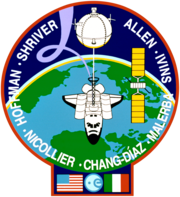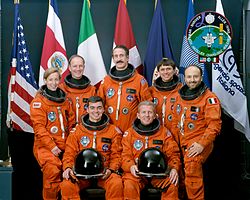STS-46
| Mission emblem | |||
|---|---|---|---|

|
|||
| Mission dates | |||
| Mission: | STS-46 | ||
| COSPAR-ID : | 1992-049A | ||
| Crew: | 7th | ||
| Begin: | July 31, 1992, 13:56:48 UTC | ||
| Starting place: | Kennedy Space Center , LC-39B | ||
| Landing: | August 8, 1992, 13:11:50 UTC | ||
| Landing place: | Kennedy Space Center, Lane 33 | ||
| Flight duration: | 7d 23h 15m 02s | ||
| Earth orbits: | 127 | ||
| Rotation time : | 90.6 min | ||
| Orbit inclination : | 28.5 ° | ||
| Apogee : | 306 km | ||
| Perigee : | 299 km | ||
| Covered track: | 5.3 million km | ||
| Payload: | EURECA , TSS | ||
| Team photo | |||
 From left to right: Andrew Allen, Loren Shriver; Back: Marsha Ivins, Claude Nicollier, Jeffrey Hoffman, Franklin Chang-Díaz, Franco Malerba |
|||
| ◄ Before / After ► | |||
|
|||
STS-46 ( english S pace T ransportation S ystem) is a mission designation for the US Space Shuttle Atlantis (OV-104) of NASA . The launch took place on July 31, 1992. It was the 49th space shuttle mission and the twelfth flight of Atlantis.
team
Main team
-
Loren Shriver (3rd space flight), commander

-
Andrew Allen (1st spaceflight), pilot

-
Claude Nicollier (1st space flight), Mission Specialist ( ESA ) Switzerland

-
Jeffrey Hoffman (3rd space flight), Mission Specialist

-
Franklin Chang-Diaz (3rd spaceflight), mission specialist

-
Marsha Ivins (2nd spaceflight), mission specialist

-
Franco Malerba (1st Spaceflight), Payload Specialist ( ASI ) Italy

replacement
-
Umberto Guidoni (ASI) for Malerba

Mission overview
The 49th space shuttle mission began with a problem-free start on July 31, 1992. With this start two nations were able to celebrate their first citizens in space, namely the Swiss Claude Nicollier and the Italian Franco Malerba .
The two main objectives of the mission were the launching of the free-flying experiment platform EURECA (European Retrievable Carrier) and the TSS experiment (Tethered Satellite Systems). EURECA was a reusable platform that contained over 70 experiments. She was suspended from the mission by the astronauts a day later than planned due to problems with her computer. As a result, the STS-46 flight was extended by one day. After igniting the satellite's engines, the burning phase was aborted a little too early, so a corrective ignition had to be carried out on the sixth day of flight of the mission in order to reach the planned altitude. A year later, the satellite was recaptured as part of the STS-57 mission .
After the successful launch of EURECA, the space tether experiment TSS was started. TSS was a tethered satellite weighing around 500 kilograms, which was supposed to float in space on a 20 kilometers long steel cable away from the shuttle. The aim of this experiment was to generate electrical energy. The cable to the satellite got stuck after about 260 meters, so practically no results could be obtained. The crew tried for several days to get the satellite free, but it failed. Therefore it was stowed back in the payload bay to return to earth.
The mission ended on August 8, 1992 with a landing at KSC in Florida.
See also
Web links
- NASA Mission overview (English)
- Video summary with comments of the crew (English)
- STS-46 in the Encyclopedia Astronautica (English)


